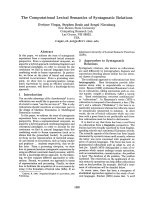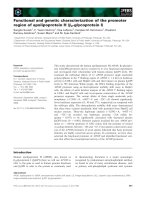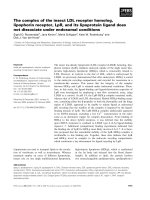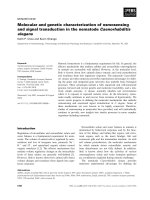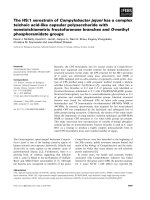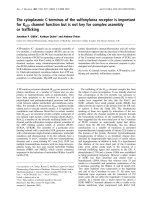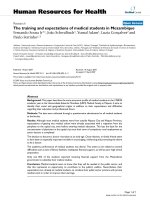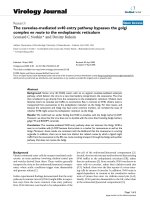Báo cáo sinh học: "The complex genetic basis of simple behavio" ppt
Bạn đang xem bản rút gọn của tài liệu. Xem và tải ngay bản đầy đủ của tài liệu tại đây (64.41 KB, 3 trang )
Jasinska and Freimer: Journal of Biology 2009, 8:71
Abstract
Genetic approaches to dissecting complex traits in animal
models increasingly use transcript levels as a molecular pheno-
type and as validation for predictio ns of gene function. A recent
study in BMC Biology using these approaches shows the
complexity of the genetic contribution to aggressive behavior in
Drosophila.
Genetic investigation of quantitative
behavioral traits
Neuropsychiatric geneticists are now focusing considerable
attention on the investigation of quantitative human
behavioral traits, postulating that such phenotypes could
be more straightforward to genetically map than neuro-
psychiatric disorders. Such syndromes are among the most
complex of human traits, a fact that may explain why
efforts to elucidate their etiology have been singularly
unsuccessful. Although quantitative phenotypes may be
simpler than clinically heterogeneous diseases, there is still
little evidence that human behavioral quantitative trait loci
(QTL) will be easy to identify. For this reason there is a
tremendous appeal in using the powerful tools available for
genetic investigation of simple model organisms; genes
implicated in behavioral variation in flies or worms can
then be targeted for various forms of analysis in mammals,
including humans. This strategy depends on the identi-
fication of suitable measures of behavior in simple systems.
Circadian rhythms are a classic example. Investigations of
clock mutants in Drosophila led to the discovery of the first
circadian rhythm gene, period, and ultimately to cellular
pathways underlying circadian behavior [1]; this line of
investigation was subsequently successfully extended in
rodents as well as humans [2].
Aggressive behavior is another complex behavioral trait
that can be efficiently modeled in Drosophila [3,4]. Yet, as
recently reported by Edwards et al. [5], aggressive behavior
in flies results from the action of numerous genes, reflects
extensive pleiotropy, and is significantly influenced by
molecular processes outside the nervous system. Perhaps
circadian rhythm phenotypes will prove more an exception
than the rule; when it comes to behavior, a simple system
does not guarantee simple genetics.
Utility of fly models of complex behavior
Given the observation that aggressive behavior in flies has
such an apparently complex genetic basis, it is worth
reviewing the motivations for using such a behavioral
genetic model. In humans it is a given that most behavioral
traits involve interactions between numerous genetic loci
in the context of multiple, mostly unquantified environ-
mental influences. No strategies implemented so far have
been sufficiently powerful to overcome the challenge repre-
sented by this degree of complexity, and the systematic
genome-wide mapping of human behavioral QTL is, there-
fore, still a nascent endeavor. This fact alone could account
for interest in investigation of behavioral pheno types in
virtually all widely used animal genetic models, including
Drosophila. Given the functional analogies of tissues,
organs and organ systems as well as the con siderable
conservation of neurobehavioral traits and of a high
proportion of gene counterparts between human and fly
[6], identification of Drosophila behavioral QTL is useful
for informing studies in other organisms, including
humans [7]. Elucidation of the molecular basis of a specific
trait such as aggressive behaviour in Drosophila could
answer several questions of generalized importance: which
genes of unknown function, gene functions and pathways
may contribute to the trait? How many genes are impli-
cated in a single complex behavior? What is their effect on
the trait in terms of magnitude and specificity?
The particular strength of the Drosophila model for beha-
vioral investigation is its suitability for various experi mental
genetic approaches. It is ideal for artificial selection for a
target trait (such as aggressive behavior) and for genetic
modification of candidate genes. In addition, it offers diverse
complex behavioral and neuroanatomical phenotypes that
can be efficiently quantified to study the putative pleiotropy
of candidate genes. For example, a quantitative aggression
phenotype has been assayed by scoring aggressive
encounters among male files that were exposed to a food
droplet after 90 minutes of food depri vation [4,5]. In
Drosophila it is also particularly straight forward to control
variations in environmental influences that might influence
behaviors, a factor that adds substan tially to the power to
identify genes that influence quanti tative traits, especially
genes contributing a small amount of the trait variance.
Minireview
The complex genetic basis of simple behavior
Anna J Jasinska
and Nelson B Freimer
Address: Center for Neurobehavioral Genetics, University of California, Los Angeles, CA 90095, USA.
Correspondence: Nelson B Freimer. Email:
71.2
Jasinska and Freimer: Journal of Biology 2009, 8:71
Genes implicated in aggressive behavior
As Drosophila has a short generation time and controlled
mating is easy, it is possible to perform artificial selection
by repeatedly selecting individuals that show extreme
scores for behavioral measures. Resulting divergent lines
with high or low aggressive behavior show significant
differ ences in gene expression for as much as 10% of the fly
genome [4]. It is likely that genetic variants directly
regulate only a relatively small fraction of the genes
contribu ting to the transcriptional response to selection for
aggres sive behavior; rather, most of these genes are
co-regulated in response to causal genes [8]. Nevertheless,
the observation that a substantial fraction of the
Drosophila genome may be related to aggressive behavior
raises interest in determining whether specific genes are
directly involved in the trait, in quantifying the magnitude
of their effect, and in evaluating whether these genes also
contribute to other traits.
The effect of a candidate gene on a complex trait in an
animal model can be directly established by functional
analysis - for example, by inducing mutation in a candidate
gene and then quantifying relevant phenotypes. Unlike
QTL mapping, which establishes relations between a
phenotype and specific underlying causative genetic
variants, mutational analysis discovers the function of
candidate genes and elucidates the molecular mechanisms
for such functions. The advantage of mutational analysis is
that it tests a role of a candidate gene on a defined isogenic
background, facilitating the detection of subtle mutational
effects. For mutational analysis Edwards et al. [5] used
P-element insertional mutant fly lines to investigate the
effects of a large series of novel candidate genes that had
not been previously implicated in aggressive behavior.
These genes were selected solely on the basis of gene
expression measures obtained after artificial selection for
this trait [4] or their known involvement in other complex
behavioral traits. Functional evidence supported a role in
aggressive behavior of a large fraction (almost 40%) of
these novel candidate genes, but mutations in them exert
only small or moderate effects on aggression level [5].
This observation supports the suggestion that the genetic
architecture of complex behavior may be remarkably
similar in organisms as neurobiologically simple as
Drosophila and as complex as humans [9]. There is now a
consensus that human neurobehavioral diseases mainly
reflect the effects of large numbers of genetic variants of
relatively small effect and, therefore, that genetic dissection
of such traits will require investigation of samples of
considerable size. The findings of Edwards et al. [5] imply
that a similar expectation may hold for QTL mapping of
aggressive behaviors in humans. Identifying the functional
importance of so many variants will obviously be more
straightforward in flies than in humans, and progress in
dissecting human traits may depend on the degree to
which they reflect molecular mechanisms similar to those
in their Drosophila counterparts.
Organismal phenotypes and pleiotropic
action of behavioral genes
One of the most interesting findings to emerge from the
investigation of aggression in Drosophila concerns the size
and localization of mutation-induced expression changes.
Edwards et al. [5] found that relatively small transcript-
level alterations (twofold or less) noticeably affect
behavior. Their observation suggests that, in considering
intermediate phenotypes for behavioral traits, it would be
unwise to ignore transcripts showing a low magnitude of
expression alterations. Their results also remind us that an
arbitrary division between the brain and the remainder of
the body may be unhelpful in efforts to understand
complex behavior. Investigations of the spatial expression
pattern of wild-type and mutant genes, using decapitated
flies, indicated that significant differences between wild-
type and mutated genes occurred for all tested genes;
however, for the majority of such genes significant differ-
ences were detected in the bodies but were not observed in
the heads [5]. Accordingly, investigations of human
behavioral traits should probably pay greater attention
than is typically the case at present to gene expression
patterns in peripheral tissues and more vigorously evaluate
other types of molecular phenotypes (such as endocrine
markers) as intermediate phenotypes. Indeed, the observa-
tions in the fly are consistent with, for example, the con-
firmed role of hormonal regulation in the development and
function of the nervous system as well as in levels and
types of aggressive behavior in various species, including
non-human primates and humans.
A single gene may generate pleiotropy by contributing to a
variety of traits. There is existing - although not abundant -
evidence that a single gene or even a single genetic variant
related to neuropsychiatric diseases may contribute to
diverse cognitive and neuroanatomical phenotypes. For
example, PER3 is implicated in a rare human circadian
rhythm disorder called delayed sleep phase syndrome, but
it is also associated with several other circadian phenotypes
and with cognitive measures, such as performance tasks
assessed during sleep deprivation and brain responses to a
working memory task assessed using functional magnetic
resonance imaging [2]. A striking observation reported by
Edwards et al. [5] is that, in flies, a very large fraction of
mutations introduced in genes related to aggressive
behavior produce extremely pleiotropic effects, affecting
various complex traits. Among the most interesting of
these traits are quantitative changes in brain morphology
observed in mutants’ mushroom bodies. These structures
were previously implicated in aggressive behavior in
Drosophila and show many parallels to an analogous
mammalian brain structure, the hippocampus, which also
has an important role in behavior [10]. The observation of
71.3
Jasinska and Freimer: Journal of Biology 2009, 8:71
pleiotropy of particular genes with respect to related traits
(such as aggressive behavior and neuroanatomical pheno-
types) may provide an important form of corroboration of
the role of a given gene in contributing to complex
behavioral traits.
Demonstrations of the importance of pleiotropy in the
genetic regulation of behavioral variation also provide
support for approaches using human genetic mapping that
attempt to take advantage of pleiotropy by identifying
various intermediate phenotypes (endophenotypes) that
link genes and disease. An endophenotype-centered
approach has two major potential advantages over genetic
mapping of disease phenotypes themselves. First, it is
hypothesized that endophenotypes are more directly
associated with genetic variation than is disease. Second,
unlike disease, endophenotypes can be investigated as
quantitative traits and are, therefore, more readily studied
in animal models.
The findings of Edwards et al. [5] indicating novel candi-
date genes and cellular processes for aggressive behavior in
the fly model provide useful information about the biology
of behavioral traits and also suggest new loci and pathways
for studies in other organisms, including humans. The
increasing sense that a universal feature of complex
behavior may be the contribution of numerous genetic
variants of small effect may influence experimental design
in human genetic studies of behavioral traits. Furthermore,
although it is often assumed that the genetic complexity of
the behavioral traits mostly reflects the complexity of the
central nervous system, Edwards et al. [5] demonstrated
the importance of also considering genes that act mainly in
the periphery. Finally, the extensive pleiotropy of
behaviorally important genes observed in the fly model
may suggest that their human orthologs exert similarly
widespread phenotypic effects. These conclusions are not
comforting for those attempting to dissect human behaviors
genetically, but they offer a reminder that sustained
investi gation of simple model systems is critically impor-
tant to these efforts.
Acknowledgements
Financial support was provided by NIH grants R01RR016300,
RL1MH083268, R01 MH075007 and R01NS037484.
References
1. Konopka RJ, Benzer S: Clock mutants of Drosophila mela-
nogaster. Proc Natl Acad Sci USA 1971, 68:2112-2116.
2. Takahashi JS, Hong HK, Ko CH, McDearmon EL: The genet-
ics of mammalian circadian order and disorder: implica-
tions for physiology and disease. Nat Rev Genet 2008, 9:
764-775.
3. Dierick HA, Greenspan RJ: Molecular analysis of flies
selected for aggressive behavior. Nat Genet 2006, 38:1023-
1031.
4. Edwards AC, Rollmann SM, Morgan TJ, Mackay TF: Quanti-
tative genomics of aggressive behavior in Drosophila
melanogaster. PLoS Genet 2006, 2:e154.
5. Edwards AC, Zwarts L, Yamamoto A, Callaerts P, Mackay TF:
Mutations in many genes affect aggressive behavior in
Drosophila melanogaster. BMC Biol 2009, 7:29.
6. Fortini ME, Skupski MP, Boguski MS, Hariharan IK: A survey
of human disease gene counterparts in the Drosophila
genome. J Cell Biol 2000, 150:F23-F30.
7. Greenspan RJ, Dierick HA: ‘Am not I a fly like thee?’ From
genes in fruit flies to behavior in humans. Hum Mol Genet
2004, 13 Spec No 2:R267-R273.
8. Hoffmann AA, Cacoyianni Z: Selection for territoriality in
Drosophila melanogaster: Correlated responses in mating
success and other fitness components. Anim Behav 1989,
38: 23-34.
9. Flint J, Mackay TF: Genetic architecture of quantitative
traits in mice, flies, and humans. Genome Res 2009, 19:723-
733.
10. Mizunami M, Weibrecht JM, Strausfeld NJ: Mushroom bodies
of the cockroach: their participation in place memory. J
Comp Neurol 1998, 402:520-537.
Published: 27 August 2009
doi:10.1186/jbiol172
© 2009 BioMed Central Ltd
